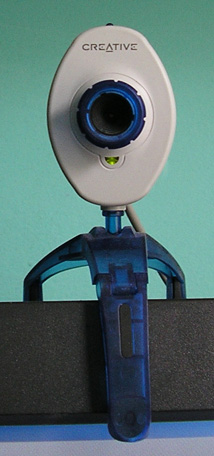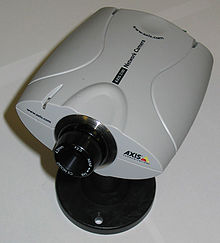Webcam

A web camera (or webcam) is a real-time camera (usually, though not always, a video camera) whose images can be accessed using the World Wide Web, instant messaging, or a PC video calling application. The term webcam is also used to describe the low-resolution digital video cameras designed for such purposes, but which can also be used to record in a non-real-time fashion.
Web-accessible cameras typically involve a digital camera which uploads images to a web server, either continuously or at regular intervals. This may be achieved by a camera attached to a PC, or by dedicated hardware. Videoconferencing cameras typically take the form of a small camera connected directly to a PC. Analog cameras are also sometimes used (often of the sort used for closed-circuit television), connected to a video capture card and then directly or indirectly to the internet.
History
Started in 1991, the first webcam was pointed at the Trojan room coffee pot in the computer science department of Cambridge University. This webcam is now defunct, as it was finally switched off on August 22 2001. The final image captured by the camera can still be viewed at the webcam's homepage [1].
As with many new technologies, webcams and webcam chat found early commercial adoption and aggressive technology advancement through use by the pornography industry. The adult industry required 'live' images and requested a Dutch developer to write a piece of software that could do this without requiring web browser plugins. This led to the birth of the 'live streaming webcam', which is still available in various forms today.
One of the most widely reported-on webcam sites was JenniCam, started in 1996, which allowed Internet users to constantly observe the life of its namesake, somewhat like reality TV series Big Brother, launched three years later[1]. More recently, the website Justin.tv has shown a continuous video and audio stream from a mobile camera mounted on the head of the site's star.
Web-accessible cameras

In addition to use for personal videoconferencing, it was quickly realised that World Wide Web users enjoyed viewing images from cameras set up by others elsewhere in the world. While the term "webcam" refers to the technology generally, the first part of the term ("web-") is often replaced with a word describing what can be viewed with the camera, such as a nestcam or streetcam.
Today there are millions of webcams that provide views into homes, offices and other buildings as well as providing panoramic views of cities (Metrocams) and the countryside. Webcams are used to monitor traffic with TraffiCams, the weather with WeatherCams and even volcanoes with VolcanoCams. Webcam aggregators allow viewers to search for specific webcams based on geography or other criteria.
Software
Webcams connected to PCs can act as web-accessible cameras with certain software; the software uploads pictures to an FTP server, from which they can be made accessible to anyone, over the web.
Usually, this kind of software is programmed to work with almost every webcam. This software can be configured in many ways, and will often include options for image size and quality, overlaying logos, and time stamping images. Many different programs to do this are available, some of them free and open source.
Videoconferencing

As webcam capabilities have been added to instant messaging text chat services such as AOL Instant Messenger, one-to-one live video communication over the internet has now reached millions of mainstream PC users worldwide. Increased video quality has helped webcams encroach on traditional video conferencing systems. New features such as lighting, real-time enhancements (retouching, wrinkle smoothing and vertical stretch) can make users more comfortable, further increasing popularity. Features and performance vary between programs.
Videoconferencing support is included in programs including Yahoo Messenger, AOL Instant Messenger (AIM), Windows Live Messenger, Skype, Ekiga and Camfrog.
Video security
Webcams are being used for security purposes. Software is available allowing PC-connected cameras to watch for movement and sound, recording both when they are detected; these recordings can be saved to the computer, e-mailed or uploaded to the internet. In one well-publicised case [2] a computer e-mailed out images as the burglar stole it, allowing the owner to give police a clear picture of the burglar's face even after the computer had been stolen.
Games
The EyeToy is a color digital camera device for the PlayStation 2, which allows players to interact with games using motion, colour detection and other means.
The Xbox Live Vision Camera is a camera designed for the Xbox 360 and Xbox Live, and can also be used for gaming applications like the EyeToy.
PC webcams can also be used for gaming applications using simple motion detection algorithms. Webcam games for PCs are available as either standalone executables, or they can even be played inside of a web browser window using Adobe Flash.
Video Effects
Software is available to display a range of visual effects in popular video chat clients such as Live Messenger or Skype. Abilities can include face tracking, automatic camera pan/tilt/zoom, video filters, frames, and even avatars controlled by the user's facial expressions.
Non-real-time webcams
A webcam that records to a video file is essentially no different from any other video camera which records directly to hard disk, including hi-def cameras such as the Thomson Viper, which would never be described as webcams. However, webcam is frequently used to describe any footage shot on the digital video cameras designed for real-time webcam use, recognizable by the distinct quality of image such cameras offer. An example of such webcam use would be in the film Dark Night by Justin Hall.
Adult webcams
One of the more common applications of webcams has been for the dissemination of Internet pornography and video chat. For many surfers the word "webcam" is synonymous with "adult webcam". Adult applications usually involve streaming video to a centralized server, where it is relayed to viewers who have subscribed to the service. The most common set-up is a model who interacts with viewers in a chatroom. Adult webcam sites are a multi billion dollar industry[citation needed] that has become a staple format for digital adult content. There are also many sites where nudity is not involved such as interactive webcam dating and / or marriage services.
Aggregators
Due to the increasing volume of webcams throughout the world, aggregator websites have arisen, allowing users to find live video streams based on location or other criteria.
Technology

Webcams typically include a lens, an image sensor, and some support electronics. Various lenses are available, the most common being a plastic lens that can be screwed in and out to set the camera's focus. Image sensors can be CMOS or CCD, the former being dominant for low-cost cameras, but CCD cameras do not necessarily outperform CMOS-based cameras in the low cost price range. Consumer webcams usually offer a resolution in the VGA region, at a rate of around 25 frames per second. The higher resolution of 1.3 Megapixel is also available from the brands Microsoft, Logitech, and HP.
Support electronics is present to read the image from the sensor and transmit it to the host computer. The camera pictured to the right, for example, uses a Sonix SN9C101 to transmit its image over USB. Some cameras - such as mobile phone cameras - use a CMOS sensor with supporting electronics 'on die', i.e. the sensor and the support electronics built on a single silicon chip, to save space and manufacturing costs.
Notably, Apple Inc. has implemented built-in webcams (that is, hardwired to the machine and irremovable) in many of its personal computer products.
Some webcams feature built in microphones to make video conferencing more convenient. Creative Technology has introduced a webcam called featuring built in noise cancellation to focus the audio to the speaker who is directly in front of the camera, excluding ambient noise.
Privacy
Some 'trojan horse' programs can allow malicious hackers to activate a computer's camera without the user's knowledge, providing the hacker with a live video feed from the unfortunate user's camera. Cameras such as Apple's older external iSight cameras include lens covers to thwart this. Most other webcams have a built-in LED that lights up whenever the camera is active.
In mid-January 2005 some search engine queries were published in an on-line forum[3] which allow anyone to find thousands of Panasonic- and Axis-made high-end web cameras accessible through the web. Many such cameras are running on default configuration, which does not require any password login or IP address verification, making them visible to anyone.
See also
- List of digital camera brands
- Creative
- Live! Cam
- EyeToy
- iSight
- LifeCam
- Quickcam
- TrackerPod
- Video camera
- Logitech
- Mobiola
- WapcamServer, a free webcam server for remote surveillance and web publishing.
References
- ^ "Plug pulled on live website seen by millions" by Oliver Burkeman in The Guardian, 3rd January, 2004
- ^ "Serial burglar caught on webcam" BBC News, 16th February 2005, retrieved 3rd January 2006
- ^ "Google exposes web surveillance cams" by Kevin Poulsen, The Register, 8th January 2005, retrieved 5th September 2006
